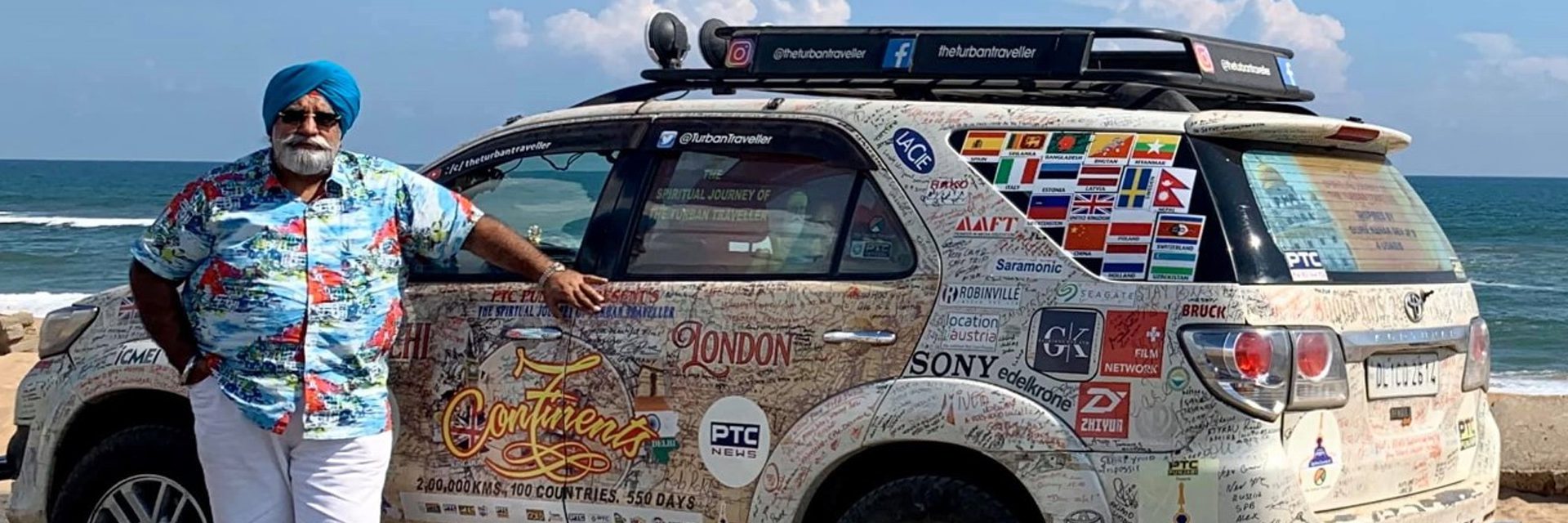(November 19, 2023) It was a beautiful evening with the sunset’s orange tint slowly turning into an alluring shade of purple and blue, and casting its magical spell on the blanket of snow beneath as Captain Aarohi Pandit was gearing up to land Pipistrel Sinus 912 in the biting cold of Kulusuk in Greenland. A nerve-racking flight of six hours and thirty minutes in an ultralight glider from Reykjavík in Iceland to Greenland, that made her think about the blurry line between life and death, made her the first woman in the world to cross the Atlantic Ocean in an ultralight aircraft. A feat she achieved at the age of 23. It took her 18 months to complete the expedition which began from Patiala in India and ended in Anadyr, Russia, touching upon countries like Pakistan, Iran, Turkey, Italy, Germany, the UK, Iceland, Greenland, Canada, and Alaska in the US. When she took off for the journey, little did Aarohi know that this would put her on the global map. “The magnitude of it struck me when I returned home and I would see people visiting me and reporters reaching out to me. Many parents came up to me telling me that wanted their kids to be like me. That’s when I realised my journey has positively impacted so many people,” she tells Global Indian.
The journey that began in July of 2018 found its conclusion in the early months of 2020 after Aarohi made a pit stop at 96 airports. Taking up the voyage at the age of 21, Aarohi credits her “excitement” for the work that she has done so far, something that soon translated into a transformative and life-changing journey. “As a pilot, that journey wasn’t like anything I have ever done or will ever do. When I left for the voyage, I had a blank slate and when I returned, I came back with 100 pages added to it,” adds Aarohi, who became the youngest woman pilot to fly solo across the Atlantic and Pacific Ocean on a light sport aircraft.

Aarohi Pandit at Whitecourt aerodome in Canada
Love for the sky and airplanes
Born in Baroda and raised in Mumbai, growing up Aarohi was fascinated by airplanes. But things accelerated when she took her first flight at the age of eight from Kochi to Mumbai and decided to become a pilot. “My parents tell me the only reason I studied in school was because I wanted to be a pilot,” she laughs. At the age of 17, she enrolled at The Bombay Flying Club in pursuit of achieving her dream. Having been able to live the dream that manifested for years was nothing short of a rollercoaster ride for her. When many pilots often describe their first flight as magical, Aarohi recalls it as a bad memory because of air sickness. “It was horrible. My head was spinning. We start with four seaters which are very sensitive to air. Even later in the day, I couldn’t concentrate on my lessons,” she laughs, adding that it took her one-two flight to acclimatise.
But as soon as she became comfortable, flying was something that came naturally to Aarohi. “I have tried many things in life but when I started flying, I realised that this was something that I could do for the rest of my life. I loved the subjects and the machines, and could understand concepts much faster than my classmates, ” says Aarohi, who with each class in flying became more confident. “It’s such a beautiful feeling to see the world from a bird’s eye view.”
After 200 hours of flight, she got hold of her commercial pilot license. A year later, an opportunity knocked on her door when the Navy Blue Foundation was “looking for young girls to take out around-the-world flight expedition in a small aircraft.” She grabbed it with both hands as a 20-year-old excited to travel the world in a light aircraft. However, the news came as a shock to her parents. “They were scared that I was ready to go on a trip across the world in a small aircraft with only a handful of flying hours under my belt. However, they finally said yes.” She soon packed her bags for Serbia, along with her co-pilot Keithair Misquitta, to acquire their glider license from Pipistrel, the aircraft manufacturer. “We trained there for 50 hours each, and returned to Pune after getting our license and started practicing flying on the new aircraft,” she reminisces.
View this post on Instagram
A journey that changed it all
Within five months, they took off for the Women Empowerment Expedition, which came with its own set of challenges, including the weather conditions that would vary from region to region. “Flying school teaches you how to fly but not how to become an aviator. Training was fun as we flew during the day and came back in the night. But the real challenge began when we took off.” They took off from Bhuj and landed in Karachi. “Seeing the LOC from the above was such an emotional moment for us as it was the first time we both were crossing the international border,” adds Aarohi, who was accompanied by her co-pilot till the UK leg of the expedition.. But after the first few flights, the weather started playing a spoiler. Being trained mostly in India and for only 50 hours in Serbia “where weather is great throughout the year to fly,” they learnt to manoeuvre through it all. “Every flight was new and we learnt during the process. You cannot beat the weather.”

Aarohi with co-pilot Keithair at Karachi in Pakistan
Being a circumnavigator required more than just flying training. “You need 8 hours of healthy sleep, maintain your diet and physical health. I couldn’t gain weight as the weight of the aircraft didn’t permit me to. The airplane weighed 470 kg including my weight, my baggage, and the fuel,” she reveals, adding that the journey required a degree of foolproof planning. “Because it was an ultralight aircraft, we needed special permits before each flight. The foremost planning was the route as we had to choose airports with fuel (diesel) availability,” she says. Moreover, ultralight aircraft aren’t allowed to fly at night so she had to take a halt every single night for those 18 months.
But it was bad weather and delays in permits that often played a spoiler. “40 percent of the permits were received beforehand. For the rest, we used to take a permit a day prior as the validity of the permit is only for 24 hours. There were also times that our permits were not approved for any reason including military movement, VIP movement, or safety issues,” she reveals, adding that she had a supportive operation team in Mumbai that helped her with procuring permits and lodging. “Hotels were booked only once we landed as there was no confirmation if would be able to make it to the place as per the date decided,” she says. Sharing her favourite memory, she recalls staying in an Airbnb in Iceland where she could see Icelandic horses daily in their full glory. “That’s something I can still not get over.”
View this post on Instagram
From a pilot to a circumnavigator
The voyage was a great learning experience for Aarohi who transitioned from a pampered child at home to a responsible circumnavigator. From flying to charting a route to manoeuvring bad weather, she did everything, including basic maintenance of the aircraft. Flying across the oceans, mountains, and in icing conditions, Aarohi made sure to go to places where Pipistrel had a hub. “We used to give our aircraft for maintenance every 50 hours. It was also a very challenging journey for the aircraft as it landed on the grass, on ice, on the runway, and cement.”
From exploring cities across the world to cross two oceans and many mountains to battling every weather condition possible, Aarohi returned as a much-learned and confident person. “My lack of exposure helped me to take on that journey. A lot of people are skeptical about going into the unknown because of their past experiences. But I was too young, with almost no experience or exposure. That helped me take the plunge.”

Aarohi before crossing the Pacific Ocean at Nome, Alaska
Making a world record
When she took off for the expedition, she did it only for a sense of adventure. But in the process, she ended up making a record. However, that wasn’t her intention as her only concern on that flight was to reach Kulusuk alive. With a -30 degree temperature and no heating in the aircraft, her legs were shivering. “I only had an insulation suit. Most of my flight was between dark clouds and rain, and everything was a mess. I kept asking myself if I was going to make it,” she recalls, adding that it was a terrifying experience for her. “It was one of the most difficult flights that I have done in the 800 hours that I have flown till now because it was something that I was experiencing for the first time. But it was worth it because when I landed, I got to know that I am the world’s first woman to do it. So, I take it as a good memory now,” she smiles. Landing in Kulusuk after a stormy affair was a perfect calm as she “could see the most beautiful colours taking over the snowy landscape. It took me 20 minutes to find the runway as it was all snow and I was mentally tired. I told my co-pilot who was waiting for me in Canada, I have got a second life.”
By achieving the feat, she has shattered the glass ceiling for women in aviation. However, it took her a while to fathom it. “I only realised it when people came up to me and told me. So many old people told me that you are living my dream. I think if I can do it, anyone else can do it too. I think when people look at me, they realise that it’s doable and it’s not impossible.”

Aarohi with Pipistrel team in Serbia
This year, Aarohi switched from ultralight aircraft to Airbus 320 as she wasn’t getting to do any more adventurous expeditions. “My father pushed me to learn a new aircraft and hone my craft, and told me that it could open up more opportunities that I am unaware of right now. The hope of getting more opportunities in the future is what keeps me going.”
The girl, who loves horse riding and working out, says that those 18 months left her humbled. “People opened up their doors to me and took care of me. All they knew was that a girl from India was circumnavigating. It enriched me like nothing else,” she signs off.
- Follow Capt Aarohi Pandit on Instagram
Read a similar story of Sukumar Das, the pilot pushing boundaries in Indian aero sports.




